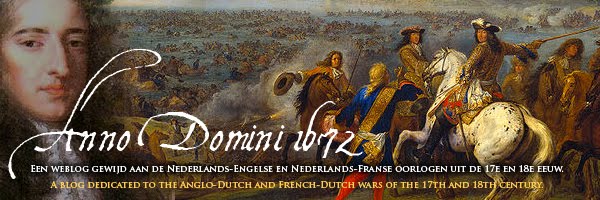.jpg)
Binnen de ingewikkelde politieke verhoudingen van de Republiek, nemen de zogenaamde Waardgelders een bijzondere plaats in: dit waren huursoldaten die tijdelijk door een stad konden worden ingehuurd, na toestemming van de Staten, in tijden van nood of om de schutterij te ontlasten. Het schilderij boven van Droochsloot uit 1628 laat het afdanken van waarschijnlijk Engelse en Franse huurlingen zien, uit de tijd van Maurits. Achter dit schilderij zit overigens een heel verhaal, wat je hier kunt vinden.
Ook in 1672 werden waardgelders ingezet. Zo vond ik op google books een verwijzing naar waardgelders uit Vlaardingen, met naam van de kapitein, en zelf een verwijzing naar hun compagniesvaandel.
The political landscape of the Republic was quite complicated, and as a result military matters are a rich source for research as well.
Next to States' paid units in the States army, there were town militia's (de schutterij), ' het uitschot' or a kind of levee en masse, and the so called 'Waardgelders', litt. translated as ' Waiting for Money'. These Waardgelders were temporary troops paid and hired by towns and cities, after permission by the States General. The picture above by Droochsloot, deals with the Prince Maurice period in which the waardgelders were used for political means.
In 1672, Waardgelders were used to supplement the troops.
In a history book on Vlaardingen (a town in the province of Holland), I found a reference on a company of waardgelders, the name of their Captain (Fagel) and a description of their company flag:
'A yellow colour with the weapon of the town (a red standing lion facing left, the Republic's 'sign') in a crest, with ornaments of leaves and fruits (orange apples I presume, to show commitment to the House of Orange), with the motto:' Watch your life and goods for the Fatherland, with courage and reason' .




salve,
BeantwoordenVerwijderenI do read your posts from time to time, and although I am not really interested that much in the intricacies of the Western European XVII century warfare, I do love these paintings, especially painted by Dutch and Flemish artists, because aside from their artistic value they are just a cornucopia of information for a student of history.
I just wanted to commend you for attaching this splendid painting to your post.
Looking forward to see more your post :)
Thank you Dario, I am very lucky that most musea have a part of their collection on-line (like the National Rijksmuseum, there's a link on the left) and sometimes I can take pictures myself.
BeantwoordenVerwijderenNice blog yourself by the way!
I often wonder if my last name Kalishoek id derived from the name Kalishock, Polish/Russian, and if we are descendant from Polish or Russian Huursoldaten, the name was first found in Vlaardingen 1630.
BeantwoordenVerwijderenIt's not unlikely, the States weren't that picky when recruting soldiers. I know of Poles in 1672 but haven't heard of Russians before Tsar Peter in dutch service... A visit to the archives could help.
Verwijderen